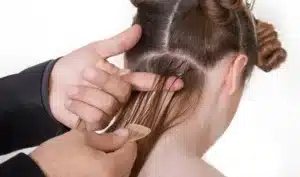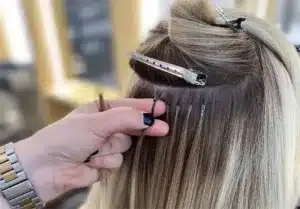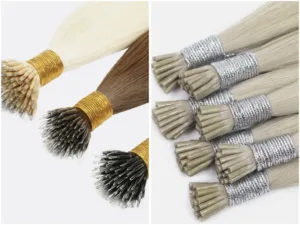Too much choice creates confusion and cost. Clients want comfort and beautiful blends. Teams want speed and predictability. A clear way to compare both wefts solves daily decisions.
Hand tied weft vs machine weft in one line: machine weft is stronger and cuttable for fast mapping,can be cut; hand-tied is thinner and flatter for the most invisible finish,but can’t be cut. Select by client density, styling habits, budget, and service time.
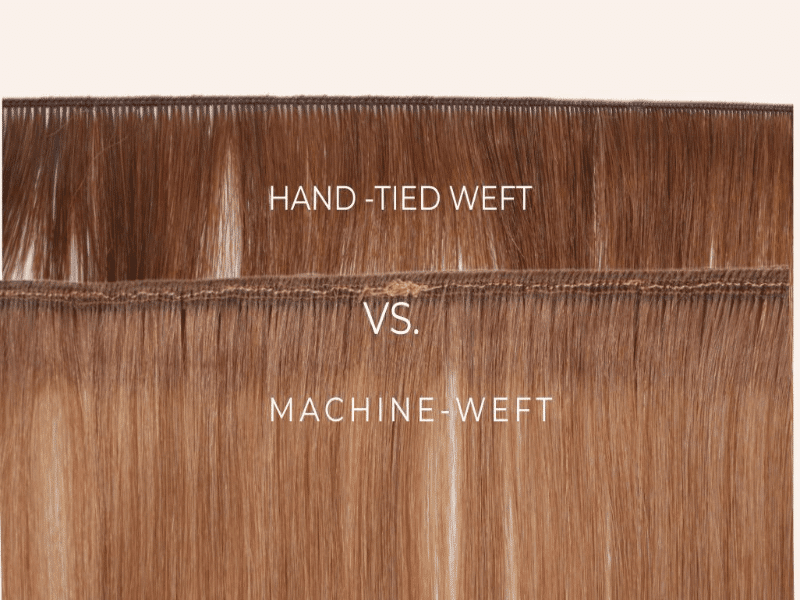
This guide breaks down construction, pros and cons, visual differences, service flow, and ordering strategy. Language stays practical for salon owners, pro stylists, and wholesale buyers who plan inventory and set client expectations.
Why does the weft type matter for results ?
Clients judge comfort and how flat the base looks. Owners judge chair time and rebook rhythm. The wrong weft adds bulk, slows installs, and increases redo work.
Weft construction changes base thickness, cuttability, stacking limits, return-hair feel, and how rows sit in updos. These factors drive photo results, day-two comfort, maintenance time, and total cost per wear across many move-ups.
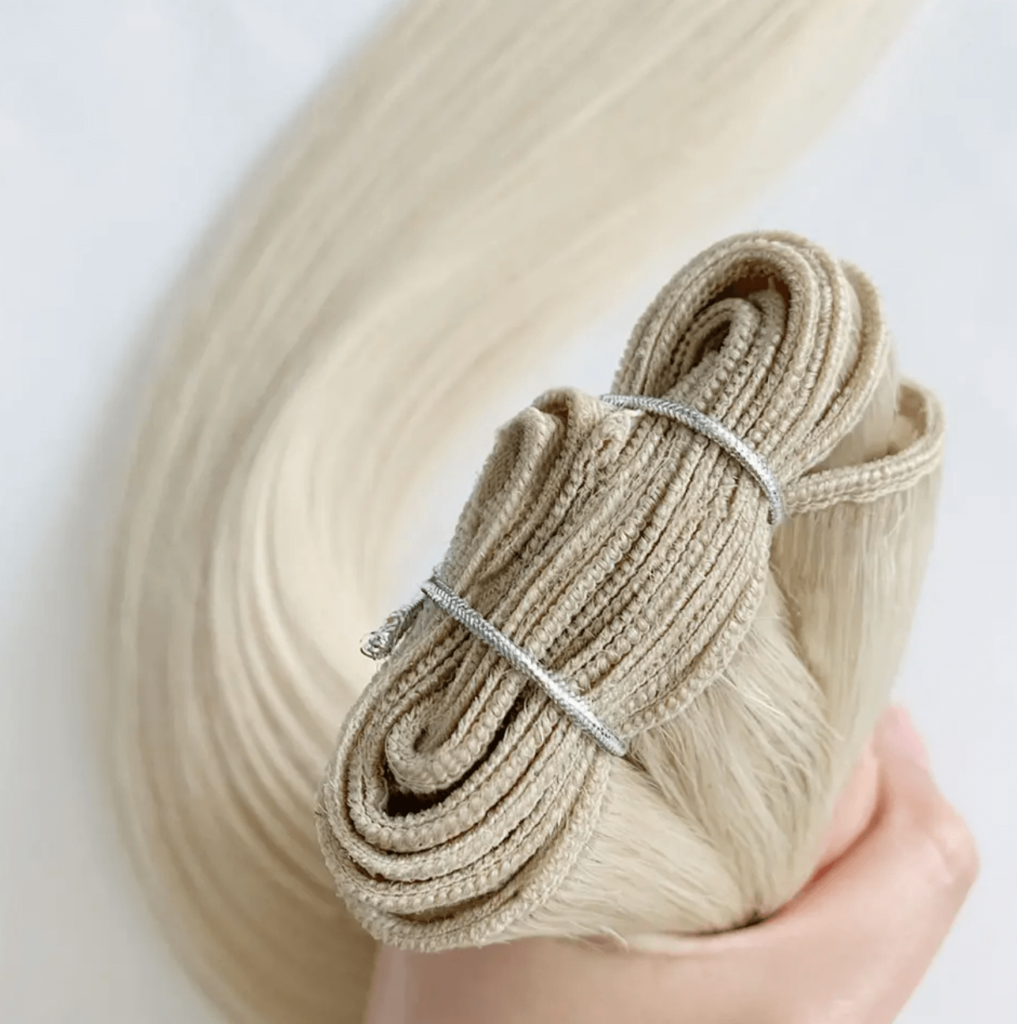
Dive deeper
A track is both an aesthetic edge and a workflow lever. Thicker tracks are sturdy and easy to cut to width. This reduces waste during mapping and speeds placement around crowns and napes. Thinner tracks lie flatter, which hides edges in high ponytails and slick looks. Return hair (short fold-back fibers at the stitch) is another lever. More return hair can feel prickly on sensitive scalps; less return hair feels smoother but often costs more to produce.
Machine wefts allow on-the-spot width changes and resealing of cut ends, so stylists tailor panels with little waste. Hand-tied tracks should not be cut through the stitch; widths must be planned or stacked. Planning adds pre-work but rewards with a very flat base when installed well.
Installation time affects profitability per appointment. Machine wefts mount quickly and tolerate repositioning. Hand-tied mapping and tension require more precision but deliver a premium blend that photographs beautifully. Maintenance flows differ as well. Both need a clean, dry base and gentle brushing. Hand-tied stitch lines benefit from loop brushes and nightly braids to reduce friction. In retail and wholesale, perceived value also differs. Clients often describe hand-tied as “lighter” and “flatter,” which supports premium pricing. Machine wefts often win in big-volume looks and time-sensitive services. The aim is not to crown a winner. The aim is to match the construction to the client, schedule, and brand positioning.
| Factor | Machine Weft | Hand-Tied Weft |
|---|---|---|
| Track thickness | Medium–thick | Ultra-thin |
| Cuttable anywhere | Yes (reseal ends) | No (avoid cutting stitch) |
| Install speed | Faster | Slower, more precise |
| Updo visibility | Good | Best |
| Return hair feel | Often present | Minimal or none |
Machine weft extensions pros and cons?
More structure speeds mapping and boosts durability. Extra bulk and return hair can add thickness at the base if stacked heavily.
Machine wefts are stitched by sewing machines into reinforced tracks. Pros: cuttable, durable, cost-efficient, broad availability. Cons: thicker base, return-hair prickliness, potential bulk near hairlines when over-stacked.
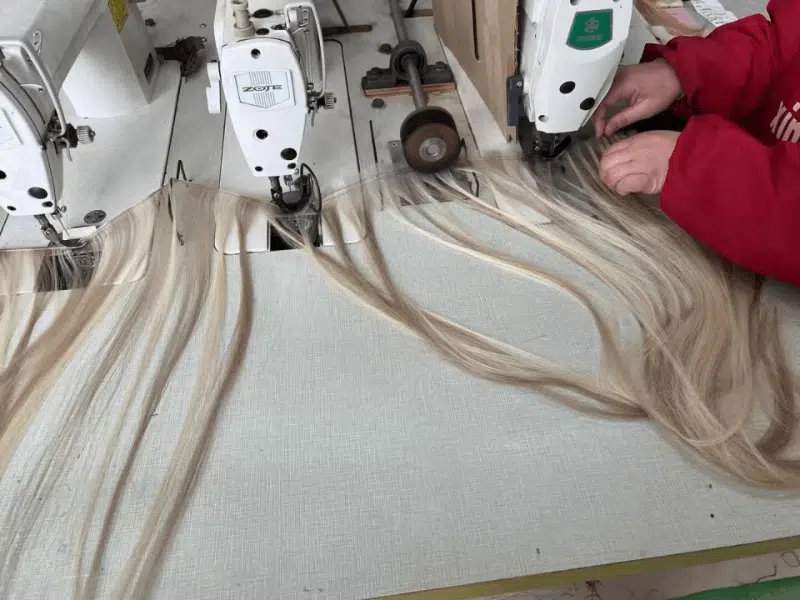
Dive deeper
What are machine wefts
A machine guides aligned hair into a two-layer (sometimes single-layer) stitched track. The seam is strong. Most versions include return hair that folds back toward the stitch. This construction supports aggressive handling during mapping and quick width adjustments.

Pros
- Cut-to-fit flexibility: tracks can be cut to any width and resealed with weft glue or adhesive.
- Speed: reinforced edges tolerate repositioning, so installs move fast.
- Durability: sturdy seam supports long lengths and high-density looks.
- Cost and supply: typically lower cost per gram and wide color runs with flexible MOQs.
Cons
- Base thickness: stacking several tracks can create a ridge in updos on fine hair.
- Sensation: return hair can feel tickly for sensitive scalps if placed too close to edges.
- Edge management: cut ends must be sealed well; poor sealing leads to fray.
| Attribute | Salon/Wholesale effect | Notes |
|---|---|---|
| Cuttability | Less waste, tailored mapping | Reseal immediately after cutting |
| Track bulk | Possible ridge in updos | Reduce stack near hairline |
| Return hair | Prickly feel for some | Place away from sensitive zones |
| Cost/MOQ | Strong value and flexibility | Good for volume and testing shades |
Hand-tied weft extensions pros and cons?
The flattest base improves comfort and invisibility. The track should not be cut; installs favor careful planning and gentle handling.
Hand-tied wefts are ultra-thin, hand-stitched curtains with minimal or no return hair. Pros: flattest profile, soft drape, top comfort, ideal for fine hair and updos. Cons: cannot cut track, longer install time, higher price per gram.
Dive deeper
What are hand-tied wefts
Skilled stitchers create an extremely thin track by hand. Many premium versions minimize return hair to avoid prickly edges. The curtain hangs softly and sits close to the scalp, which improves blend on fine or low-density hair.

Pros
- Ultra-flat base: edges disappear in high ponytails and slick styles.
- Comfort: minimal bulk reduces scalp awareness and improves day-two feel.
- Blend: thin stack allows 2–4 wefts per row without obvious ridging.

Cons
- Do not cut the stitch: cutting causes unravel. Widths must be pre-selected or achieved by stacking.
- Time: mapping and mounting take longer and require consistent tension and spacing.
- Cost/lead time: hand craftsmanship can raise unit price and extend delivery windows.
| Attribute | Salon/Wholesale effect | Notes |
|---|---|---|
| Track profile | Most invisible finish | Ideal for fine hair |
| Mapping | Plan sizes; stack | Avoid cutting stitch |
| Handling | Gentle at stitch line | Loop brush; night braid |
| Pricing | Premium positioning | Higher perceived value |
What is the difference between hand-tied and machine weft?
Both add length and volume, but the base, mapping, and stacking rules are different. These differences change comfort, visibility, and chair time.
Machine weft vs hand tied in practice: machine weft is thicker, cuttable, and fast; hand-tied is thinner, not cuttable, and blends best. Choose by density, style goals, time, and budget.
Dive deeper
Base and bulk
Machine tracks carry more material at the seam. This increases durability and cuttability but can print through on very fine hair when stacked. Hand-tied tracks are minimal. They lie flush and reduce print-through, which helps with tight ponytails and clean lines around partings.
Cuttability and waste
Machine wefts cut to size on the spot and reseal. Mapping is flexible, and waste is low. Hand-tied tracks should not be cut, so widths must be planned or achieved with more pieces. This pushes teams to pre-plan shapes but pays off in the flattest result.
Return hair
Machine seams often include return hair, which may feel prickly if placed too close to hairline or crown swirls. Hand-tied seams usually have minimal return hair, so the base feels smoother.
Maintenance
Both require the same home-care fundamentals: support the base while brushing, wash 2–3× weekly, condition mid-lengths to ends, dry the base fully, protect with moderate heat, sleep with low friction. Hand-tied stitch lines benefit most from loop brushes and nightly braids.
| Dimension | Machine Weft | Hand-Tied Weft |
|---|---|---|
| Base thickness | Medium–thick | Ultra-thin |
| Cut anywhere | Yes | No |
| Return hair | Common | Minimal/none |
| Updo invisibility | Good | Excellent |
| Install speed | Faster | Slower |
Which clients and styles fit each weft best?
Different densities and style habits call for different bases. Matching reduces redo work and improves referrals.
Machine weft suits dense hair, dramatic volume, and faster appointments. Hand-tied suits fine hair, frequent ponytails, and clients who value ultra-flat finishes.

Dive deeper
Density and sensitivity
- Fine or fragile hair benefits from the thinnest track. The edge hides better, and comfort improves.
- Medium to dense hair tolerates more base thickness and often seeks larger volume jumps, where machine wefts stack efficiently.
Styling habits
- High ponytails, slick-back looks, fitness routines, and wind-prone settings expose edges. A thin base hides better and keeps styles clean.
- Down styles and glam volume benefit from sturdy tracks that hold long lengths and weight.
Time and budget
- Time-sensitive schedules favor machine wefts for quicker mapping and mounting.
- Premium experience and photo-first branding favor hand-tied for the softest, closest-to-scalp result.
| Profile | Better pick | Why |
|---|---|---|
| Fine hair, visible scalp | Hand-tied | Minimal print-through |
| Daily ponytail / athlete | Hand-tied | Clean edges in updos |
| Max volume, long lengths | Machine | Strong seam, fast stacking |
| Short appointment windows | Machine | Cut-to-fit speeds mapping |
How do installation, maintenance, and rebooking differ in salons?
Daily care rules are the same. Service timing and handling at the base differ by construction.
Both wefts commonly rebook at 6–10 weeks. Machine wefts map and mount faster. Hand-tied requires gentler brushing at the stitch and careful tension during move-ups.
Dive deeper
Installation flow (general practice)
Machine wefts accept quick width cuts and immediate resealing. This allows flexible paneling around whorls and hairlines. Hand-tied mapping depends on pre-set widths and strategic stacking; teams space beads and rows to keep tension balanced and edges hidden.
Home maintenance (client instructions that salons often give)
- Brush twice daily while supporting the base; start at ends.
- Wash 2–3× weekly with sulfate-free shampoo; condition mid-lengths to ends.
- Dry the base completely after every wash or heavy sweat.
- Use heat protectant; keep tools at moderate temperatures (about 355–375°F / 180–190°C).
- Sleep in a loose braid on a silk/satin pillowcase.
Rebooking
Growth rate, workouts, and water exposure change timing. Athletes and swimmers may need earlier visits. During move-ups, careful handling of stitch lines preserves hand-tied tracks. Machine seams tolerate faster removal and re-mounting.
| Step | Machine Weft | Hand-Tied Weft |
|---|---|---|
| Mapping | Cut-to-fit, reseal | Pre-sized, stack |
| Handling at base | Rugged | Gentle at stitch |
| Typical cadence | 6–10 weeks | 6–10 weeks |
| Common pitfalls | Over-stacked bulk | Cutting the stitch; rough brushing |
What about cost, MOQ, lead time, and inventory planning?
Operations drive profit. Construction affects cash flow, storage, and seasonality response.
Machine weft often brings lower unit cost, flexible MOQs, and quick replenishment. Hand-tied often brings higher perceived value and premium positioning but longer craft lead time.
Dive deeper
Supply chains scale differently by construction. Machine wefts rely on predictable sewing capacity with broad color runs and standard lengths, which supports agile restock and small tests of new shades. Because tracks are cuttable, salons and distributors reduce dead inventory by tailoring widths in service. This keeps drawers cleaner and frees cash.
Hand-tied production depends on skilled stitchers. Output per day is lower, and quality control requires more time. Lead times can extend in peak seasons. The upside is brand differentiation. Clients often describe hand-tied as the most comfortable and the most invisible in updos. Many businesses present hand-tied as a premium tier with higher service pricing, longer consultations, and photo-forward marketing. Both lines can coexist. A two-tier menu helps match budgets and expectations while stabilizing inventory turns.
| Metric | Machine Weft | Hand-Tied Weft |
|---|---|---|
| Unit cost | Lower (often) | Higher |
| MOQ flexibility | Higher | Medium |
| Lead time | Faster | Longer (craft) |
| Inventory waste | Low (cuttable) | Requires planning |
| Retail positioning | Value/performance | Premium/comfort |
My opinion
As a hair extensions manufacturer,I can tell you that the both two wefts are selling well.Two clear lanes work best: a performance lane for speed, cut-to-fit efficiency, and bold volume (machine weft); a premium lane for ultra-flat comfort and high-ponytail aesthetics (hand-tied). I think present both, let clients feel sample tracks, and match the lane to density, styling habits, and time. This approach reduces redo work and supports predictable rebooks.
FAQ
Which lasts longer: hand-tied or machine weft?
Lifespan depends more on hair quality and home care than on the track. With full-cuticle hair and correct care, both can be reused across many move-ups.
Can hand-tied wefts be cut?
Do not cut through the hand stitch. Plan widths or stack additional pieces instead.
machine weft vs hand tied—what about high ponytails?
Hand-tied tracks sit flatter and stay hidden more easily in tight updos and ponytails.
Will machine wefts feel bulky?
They are comfortable for most clients. Bulk appears when many layers stack near hairlines; smart mapping reduces this.
What is better for fine hair?
Hand-tied usually blends best because the base is ultra-thin.
What about return hair “prickle”?
Machine tracks often include return hair. Place away from sensitive zones or select constructions with shorter return hair. Many hand-tied options minimize return hair.
Do both types need the same aftercare?
Yes. Support the base while brushing, wash 2–3× weekly, condition mid-lengths to ends, dry the base fully, protect from heat, and braid at night.
How does pricing compare?
Machine weft usually costs less per gram and installs faster. Hand-tied often sits in a premium tier due to comfort and finish.
Is there a single best choice?
No. The best choice depends on density, style habits, desired finish, time, and budget. Keep both options available.
Conclusion
Use machine wefts for cut-to-fit speed, durability, and big volume. Use hand-tied for ultra-flat comfort and invisible blends. Match construction to density, style goals, time, and budget for the best long-term results.
Hibiscus Hair Manufacturer has been dedicated to producing high-quality weft hair extensions for 25 years and is a recognized leader in the industry. If you are interested in finding a reliable hair extensions supplier and wholesale for your brand, please visit our website for more information:
Hand tied Weft Hair Extensions
Machine Weft Hair Extensions

